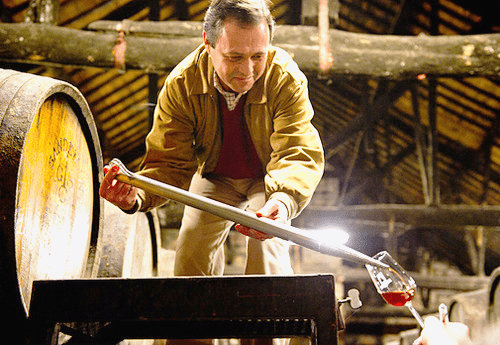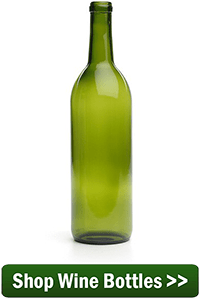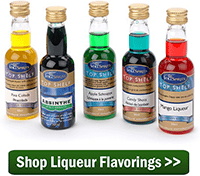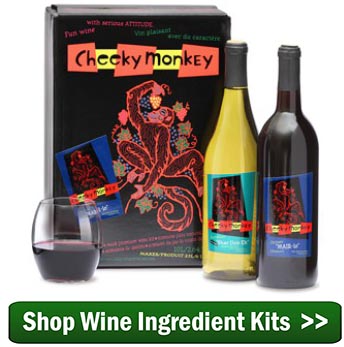 Have you ever thought about fortifying homemade wine. It’s an interesting style that’s made through a relatively simple process. You might want to see if it’s something you’re interested in…
Have you ever thought about fortifying homemade wine. It’s an interesting style that’s made through a relatively simple process. You might want to see if it’s something you’re interested in…
If you don’t know what a fortified wine is, it’s a wine to which brandy or some other spirit has been added. Since brandy and other distilled products are high in alcohol – typically around 40% or 80 proof – this will raise the finished alcohol level of the wine. The home winemaker can do the very same thing by adding brandy to homemade wine.
From a traditional standpoint, fortification was done to make a wine more stable during long trips by ship or by cart. The wine’s alcohol level was raised to around 17% to 22% with the addition of brandy. The higher alcohol level acted as a preservative, diminishing the chance of spoilage during the long journey.
The big three fortified wines that most people have heard of are: Sherry, Madeira and Port. All three are Old World wines: Sherry originating from Spain, Madeira and Port from Portugal.
 The first thing the home winemaker needs to understand before making fortified wine with their homemade wine is that this process can be somewhat costly. For a five gallon batch of wine it takes five fifths (750ml) of brandy to raise the batch by 6-2/3 percent alcohol. With a typical fortified wine being about 20% alcohol and the cheapest bottle of brandy being about $10 to $13 a bottle, making fortified wine can be somewhat cost prohibitive.
The first thing the home winemaker needs to understand before making fortified wine with their homemade wine is that this process can be somewhat costly. For a five gallon batch of wine it takes five fifths (750ml) of brandy to raise the batch by 6-2/3 percent alcohol. With a typical fortified wine being about 20% alcohol and the cheapest bottle of brandy being about $10 to $13 a bottle, making fortified wine can be somewhat cost prohibitive.
With this in mind, the best strategy for the home winemaker is to get as much alcohol as they can from the fermentation, itself. To learn how to get the most alcohol out of a fermentation you might want to go over the article, Making High Alcohol Wines listed on our website.
Here is a calculator listing that shows how much the alcohol is raised in a 5 gallon batch with each additional 750ml bottle of brandy or other distilled spirit. This is assuming that they are 40% alcohol by volume (80 proof).
1 Bottle adds 1.5%
2 Bottles add 3.0%
3 Bottles add 4.3%
4 Bottles add 5.5%
5 Bottles add 6.7%
6 Bottles add 7.7%
7 Bottles add 8.8%
 You will want to shoot for a total alcohol level of 17 to 22 percent. So if you have a batch of wine that has fermented to 14 percent alcohol, you might add 4 bottles to raise the total alcohol level to 19.5% (14.0 + 5.5).
You will want to shoot for a total alcohol level of 17 to 22 percent. So if you have a batch of wine that has fermented to 14 percent alcohol, you might add 4 bottles to raise the total alcohol level to 19.5% (14.0 + 5.5).
When fortifying wine, you can use a regular brandy made from grape wine such as E&J and add it to a red wine you have made. This would be the most straightforward way of adding brand to a homemade wine. But there are also some other, more imaginative, things you can do.
For example, you could take a blackberry brandy and add it to a blackberry wine, or use a peach brandy to fortify a peach wine. You could also take a Merlot wine and add to it a raspberry brandy to accent its flavors. With all the different types of brandys that are available, the combinations are endless.
It is important that you make sure the fermentation is done before fortifying the wine with brandy. Once the wine has been fortified you will have great difficulty getting the wine to ferment, ever again. Not only does fortifying wine help to stop spoilage, it helps to stop fermentation.
 After fortifying the wine, continue on as you would with making any other wine. If you are using a wine ingredient kit continue following the directions. If you are making wine from fresh fruit, give the wine plenty of time to clear and bottle as you normally would.
After fortifying the wine, continue on as you would with making any other wine. If you are using a wine ingredient kit continue following the directions. If you are making wine from fresh fruit, give the wine plenty of time to clear and bottle as you normally would.
As you can see fortifying wine is not all that complicated. It is mostly a matter of adding brandy to a homemade wine. And, it makes a wonderful after-dinner wine. The brandy’s intensity combined with the original wine’s character, creates a powerfully, pleasant drink.
—–
Ed Kraus is a 3rd generation home brewer/winemaker and has been an owner of E. C. Kraus since 1999. He has been helping individuals make better wine and beer for over 25 years.

Here’s the actual method for making port wine (learned in portugal).
First, forget about the 40% (80 proof) stuff, it will dilute your wine/taste too much.
In Portugal, they call brandy(aguardente) the distillate from grape skins that is at around 67%+ and is not aged in barrels(neutral). A workaround would be to mix 94% alcohol with neutral grape spirits or pisco to reach the 67%.
Also, the fermentation is not completed, but stopped by addition of the “brandy” when 5 to 10% alcohol has been fermented so that the remainder of the sugar is the port’s sweetness…
So :
-12-14% brix juice start fermentation
-The measurer dropped by +-8% : Stop fermentation with 67% neutral grape spirits to reach 18-20% alcohol.
By now, the yeasts die due to high levels of alcohols
-Age with -small- amounts of oak if desired.
-Enjoy
Why not use Everclear or Vodka which would be a cheaper option? I added Everclear to my 6 gallon batch of peach wine and it turned out great.
Dave, there is certainly no reason why you can’t do this. For the sake of flavor balance, when you add more alcohol, you usually want to add more flavor as well. Brandy does this. Without the additional flavor, a hot wine can taste watered-down. In the case of your peach wine, you might have considered adding peach brandy.
Just made my first batch added ever clear and distilled water not bad
I have had good success using the EC Kraus recipes for blueberry and cherry wines adapted to make port. I increased the amount of fruit by 50% (e.g. 15 pounds instead of 10 pounds), fermented with regular yeast (Montrachet), and then fortified with Korbel brandy when the alchohol is about 12% and brix was about 10. Final alcohol level is 18% to 20%, brix 7, and an increase in final volume of about 30% with the brandy addition. The fortification stops fermentation and the yeast drops to the bottom. This approach is a good way to control the final level of desired sweetness in the port. I have also made Syrah port this way, but fortified at 5 brix with a final brix of about 3 for a slightly dryer port.
I use 100 proof Southern Comfort and get the alcohol content of my wine as high as possible.
Why even bother coming into our world everybody with a comment supporting store bought liquor being mixed with home made wine or shine has no place here sorry but you don’t get you alcohol content by mixing with store bought liquor. You get it by learning and mastering a traditional way of lifestyle I personally make both and id sit either of my juices against anything you buy. Its a sad thing to see what a small few of us still have an respect for what we do. And now days seems alot of people wanna support a title they aren’t worthy of.. I just racked 5 gallons of blackberry wine to sit up for another month then it will be distilled or I have a 180 proof shine I also made that could be blended in…. to all those who still respect the art of creating a liquid signature for themselves shine on my friends and for the rest of ya looking for a quick fix to boost your low level juice goodluck
Brian,
I love your comments…… My wife and I just returned from a vacation in the Duro Valley of Portugal. That is exactly how they do it…….they use the skins, seeds, stems and some of the residual pressings and distill it…..they infuse this right back into the blend of their original juice that they have made the wine with itself. I tried to, without success of course, to get the blend or ratio…… no way was that going to happen, but I tried.
I live in Wisconsin and use juice from Frontenac grapes (because that is what I grow) to make a port style wine. I add Hartley brandy because it’s the cheapest. I’m planning a trip to Portugal and Spain and would very much like to get some tips on places to visit and see. I would appreciate feedback.
Agreed
Brian, That’s some pretty exclusionist elitist thinking right there. Each person is on their individual journey in this craft, and begins somewhere. We get it. You are cool and distill your own spirits to add to your wines. Others maybe aren’t willing to commit a felony to experience your so-called “traditional way of life”, assuming they are in the States. Based on your disdain for store-bought liquor as an ingredient, I’m assuming you only harvest wild yeast, grow all your own ingredients, and never use any StarSan, PBW, sugar, camden tablets, potassium sorbate, acid blend, yeast nutrient, or finings since these, too, are store-bought. This is literally a comment, posted on a website, provided by a store! All I’m saying is, with a start like “Why even come into our world…”, you are turning off others to the people in a wonderful and fulfilling craft where people don’t have to set up a farm, winery, and distillery just to get in the door. From a bucket, juice, and bread yeast to stainless steel tanks feeding barrels, we’re all somewhere along that journey, and we ALL have something to teach and learn.
Someone who makes sense. A rare thing in this world of arrogant hot heads!
Thank you Shannon. When it comes to making the best wine, one should always try to get the best grapes one can (preferably from a known, single source). But i live in North Carolina, established a 4 acre vinifera vineyard and grew/vinified the best Cabernet, Syrah, etc. I could produce. Finally, I surrendered to our challenging climate and gave up. So, now I pick super ripe Ison muscadines and experiment . I have used whole cluster fermentation to try to “tone down” the native “muskiness” of the grape itself and this year i decided to fortify and let the higher alcohol and sweetness work for me. I think I may be on to something–come Christmas i will serve it in front of the fire and se what folks think. It has been great fun. I am experimenting further by using a combo of very local sorghum syrup along with cane sugar to get a darker, deeper port.
I will gladly “come into Brian’s world” and have some fun rather than criticizing the passionate efforts of mere amateurs (after all that means we “love it”)
I love the idea of what you do, one of the reasons I like brewing beer and making wine, but it is illegal to distill alcohol where I live so adding some from the store is a nice compromise for some of my wimpier wines
Wow Brian it’s sad to hear that you have made shine. See there is no place in this group for you to make shine unless you happen to be a certified tig welder and can spend the time and money purchasing thousands of dollars in food grade stainless steel and make your own still. Which I happened to have made, because I happen to be a certified welder. See how I did that? You know called you out. Some of us have other stuff to do than sit around and be on beckoning call for 5 gallons of fruit juice. But again that’s just me being me.
Do you press the grapes with your feet? that is the traditional way. Or do you you a store bought press or buy already pressed juice?
I make spirit from a home still which I enhance with
blackberrys,Can I add same to kit wine to make a kind
of port
Brendan
Brendan, yes you can. You want to add enough or your “makin’s” to bring the alcohol level up to around 18 to 22%.
I didn’t see any mention of ice wine. I make a lot of different fruit wines and occasionally will freeze and drain off the spirits. This leaves behind a lot of water.Would this be considered a fortified wine?
Jason, first let me clear up something. Ice Wine is made from the juice of frozen grapes. What you are referring to is like making Applejack. Freezing wine and removing the water is not the same as a fortified wine. Freezing the wine and removing the water is not exactly distilling but does fall under the distilling category. Please keep in mind while making wine/beer is legal, anything falling under the distilling umbrella is not legal. Now the difference, when you freeze the wine you are concentrating the flavor as well as the alcohol. When you make a fortified wine b adding stilled spirits, you are diluting the flavor while adding the alcohol. I hope this information helps.
thank you for the comments on fortifying wine
Mr.Kraus, I have a finished blackberry raspberry wine that is 12% I would like to fortify it with wild Turkey 101 to 17% or 18% this is a gallon experiment! How much do I add?
Brian, the Wild Turkey 101 has 50.5% alcohol so according to our calculations, you would add about 23 ounces to achieve approximately 18% alcohol in a one gallon batch of 12% wine.
Mr Kraus
In keeping with my father’s Portuguese tradition, I am making some Madeira wine. I have 8 gallons I want to add Graves 190 proof to fortify it. Is there a formula I could use before I put myself to sleep after drinking a cup?
Coach John, our best recommendation is to use the guide in this article that tells you how much one 750ml bottle of brandy or other distilled spirit will increase the alcohol content in a 5-gallon batch and adjusting it to the 190 proof as opposed to 80 proof. Basically, you will be using less than half of what is called for using 80 proof.
Can the Pearson Square be used to calculate how much spirits to add to the wine?
Jason, yes the Pearson Square can be used to help determine how much Brandy or distilled alcohol to add when making a fortified wine. For more information, please see the article link posted below.
Pearson Square
http://www.eckraus.com/blog/pearsons-square-wine-blending-fortifying
I am making a tart cherry wine. I don’t want to fortify my wine. I just want to enhance the cherry flavor. If I use one of the liqueur flavorings, do I also need to purchase the base to use with it? Thank you!
Mary, If you are adding the liqueur flavoring to your wine, you do not need to use the base.
I’m making a 3 gallon Chocolate Raspberry wine and a Chocolate Salted Carmel wine and I would like to add some brandy to each of them do you have a good brandy I should use? Also how much should I add
Rob, we do not have a particular brandy to recommend. With as much brandy that it takes to fortify wine, we would use an inexpensive brand. As far as how much to add, to fortify wine you are looking for an alcohol level of 17-22 percent as the article states so we recommend using the chart that is included in the article above.
I’m making a blueberry lemonade wine but after making the standard hard lemonade I wanted to boost the flavor of the blueberry lemonade. They have a blueberry lemonade rum or 100 blueberry liquor which I’m thinking of using. Any other ideas or amounts to use for 5 gallons.
Rene, if the rum or the liquor is 20% alcohol(40 proof), you can just use the chart in this article for using brandy. If the alcohol content is less or more you would just adjust the dosage accordingly.
Fortified wines can be a lot of fun to experiment with. I use either Merlot or Grenache or both grapes together as my base, fermenting it the way Ed recommends and stopping the fermentation with Clear Spring 190 proof. Being so strong it reduces the amount of dilution by alcohol because I use less. After pressing I then crush some of the Marquette grapes I grow and add it to the mix. I then let the alcohol extract the fresh fruit flavours from those grapes for several months, rack it and bottle a few months later. Adding back the Marquette grapes makes for an interestingly intense fruitiness that is somewhat different from the mellow fruitiness that the wine would have without adding back the fresh grapes. It retains that fruitiness even after 3 years ageing.
WOW, great article.. I love reading all your emails. I been making homemade wine for 5 yrs. now. & have been getting better . I was wondering how to get my Peach wine more Punch in flavor. The alcohol is usually around 15% , adding peach Brandy is a Great Idea. I will have to do 2 batches next yr. as I have a Peach tree & get plenty of fruit.. Thanks again to E.C Krauss for another informative article..
Sincerely Charlie P. in N.J.
So I have 1.5 gallons of Tempranillo must that started out at 26.3 brix, and fermented it down to 10 brix (to leave that residual sugar) and added a 1.75 liter bottle of regular Monarch brandy (40% ABV) and a 750 ml bottle of Leroux Kirschwasser (45% ABV) and mixed it super well, but it doesn’t seem to have stopped the fermentation. By my calculations, that “should” have been enough brandy to raise the ABV to about 19-20% right??? So why is it still fermenting? I used RC212 wine yeast- is that a higher alcohol tolerant yeast?
Mark, your alcohol volume is right there where it should have stopped fermentation, however it is never a guarantee. If you were to add brandy to get the ABV up to 22 percent or so it will probably stop the fermentation. However, if you are happy with the taste as it is now, you can put it in the refrigerator for about 3 weeks so that the yeast will drop out and then add potassium sorbate.
Hi,I’ve made my first home brew Merlot wine, it tastes far too sweet my plan is to add brandy,approx how much Brandy to a bottle of wine would you suggest.i think the wine is too sweet because the fermentation process wasn’t warm enough ? My favourite drink is Port unfortunately I like it too much hence the wine making lol!
Gary, if the fermentation did not complete, we would recommend getting it to complete before bottling. If you do not, it could start to ferment in the bottle and that could cause a big mess. We have posted an article link below on the most common causes of fermentation failure. As for how much brandy to add to each bottle of wine, we cannot tell you how much to add per bottle wine.
Top Reasons For Fermentation Failure
https://eckraus.com/wine-making-failure/
I have enjoyed some of the commercial wine that has been whiskey or bourbon barrel aged. I’m wondering if I could add a little bourbon to 5 gallon cab, blend that is aging. I would like to add flavour but not fortify. Is this a thing and if it is how much would add just a bit of flavour?
It will certainly get you closer to that particular character, but not all the way there. The wine is also extracting from the wood itself. You might be better off soaking some of our toasted oak chips in bourbon for a few day, then add the chips to the wine. Just a thought.
Many of these comments are asking about how much of this or that to add, and your answers always refer to commenters to a chart which will approximate what they need. Everyone here is using the Internet so they can Google a Pearson Square, which will automatically calculate exactly what proportions required.
My blackberry wine hit 16 percent. Satisfied with mine at these levels.
I work at a bar and am wanting to simplify one of our cocktails by batching some of the ingredients. I know some things I can do regarding syrups and juices, but was wondering what the shelf life would be on combining mint infused vodka with moscato? Any help or information would be appreciated!!